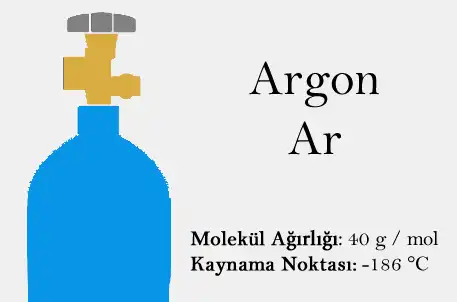Argon gas is a colorless, odorless, and unreactive gas in the noble gas group (group 18) of the periodic table. Its symbol is Ar and it is found in the atmosphere at a rate of approximately 0.93%. It is a very stable element chemically and does not react easily with other substances. Due to this feature, it is used in a wide variety of areas in the industry.
Properties of Argon Gas:
- Inert Gas: It is a chemically inert, i.e. non-reactive gas. This allows it to be used in applications that need to prevent chemical reactions.

- Colorless and Odorless: It does not have a visible or perceptible feature. Therefore, special equipment is required in applications such as gas leakage control.
- Heavy and Dense: Argon is heavier than air and therefore can accumulate in closed environments.
- Non-Flammable: Since argon gas is not flammable, it provides a safe environment without the risk of fire.
Areas of Use:
- Welding Processes:
Argon is widely used especially in TIG (Tungsten Inert Gas) and MIG (Metal Inert Gas) welding. In these processes, argon gas prevents oxidation of metals by isolating the welding area from oxygen and increases the welding quality.
- Lighting and Electric Tubes:
Argon gas is used in fluorescent and incandescent lamps. Argon facilitates the passage of electric current and extends the life of the bulb.
- Semiconductor Production:
Argon is used in the semiconductor and electronics industry to create an inert atmosphere free of oxygen and other gases during the production stages.
- Glass Production:
It is used as a protective atmosphere in glass production. It is also one of the gases filled between double-glazed windows, thus providing better insulation.
- Medical Applications:
Argon gas is also used in surgical laser procedures and cryogenic applications.
- Food Packaging:
Argon is also used in some food packaging processes. Argon-filled environments are created to prevent food from reacting with oxygen, which accelerates the deterioration of food.
Advantages of Argon Gas:
- Non-Chemical Reactions: This ensures the protection of materials in sensitive processes such as welding and electronics.
- High Heat Resistance: Argon gas remains stable even at high temperatures, making it suitable for processes requiring high temperatures.
Safety Precautions:
- Risk of Asphyxiation: The presence of high concentrations of argon in closed areas can displace oxygen and create a risk of asphyxiation. Therefore, it is important that areas where argon is used are well ventilated.
- Pressure Cylinders: Argon is usually stored in high-pressure cylinders, so safe transportation and storage of the cylinders is necessary.
Argon gas is a safe and stable gas that is widely used especially in industrial and technical applications.
 English
English
 Türkçe
Türkçe


